How do flame retardants work?
Release time:
2024-03-12 08:42
Shandong Chenxu New Material Co., Ltd. is a modern and professional flame retardant enterprise integrating production, sales and research and development. It has a wholly-owned subsidiary-Jinan Chenxu Chemical Co., Ltd. and a production base. The main production of flame retardant and flame retardant electronic potting glue two series of more than a dozen varieties. The company's products mainly include flame retardants, antimony trioxide, zinc borate, ammonium polyphosphate, TCEP flame retardants, aluminum hydroxide, magnesium hydroxide, aluminum hydroxide, chlorinated paraffin, etc., which are widely used in engineering plastics, rubber pipe belts, coatings, plastic films, cable materials, electronic appliances, intelligent computer version, water treatment and other fields.

The mechanism of action of flame retardants is complex and not yet very clear. It is generally believed that a halogen compound undergoes a decomposition reaction when exposed to fire, and the decomposed halogen ion reacts with a polymer compound to generate a hydrogen halide. Flame retardants exert their flame retardant effects through a number of mechanisms, such as endothermic effects, covering effects, inhibition of chain reactions, and asphyxiation of non-combustible gases. Most flame retardants achieve the purpose of flame retardancy through the joint action of several mechanisms.
The heat released by any combustion in a relatively short period of time is limited. If a part of the heat released by the fire source can be absorbed in a relatively short period of time, the flame temperature will be reduced, and the radiation will be on the combustion surface and act on the combustible molecules that have been vaporized. The heat of cracking into free radicals will be reduced, and the combustion reaction will be suppressed to a certain extent.
Under high temperature conditions, the flame retardant has a strong endothermic reaction, absorbs part of the heat released by combustion, reduces the temperature of the combustible surface, effectively inhibits the generation of flammable gases, and prevents the spread of combustion. The flame retardant mechanism of Al(OH)3 flame retardant is to increase the heat capacity of the polymer, so that it can absorb more heat before reaching the thermal decomposition temperature, thereby improving its flame retardant performance. This kind of flame retardant gives full play to its characteristics of a large number of heat absorption when combined with water vapor, and improves its own flame retardant ability.
Flame retardant manufacturers
Previous Page
Previous Page
Popular product recommendations
CONTACT US
Sales call:+86 531-87978111
Fax:+86 531-87972518
Email(Login):cxcn@chenxuchem.com
Address: South of East Extension, Chuangxin Street, High-tech Development Zone, Yucheng City, Shandong Province

Wechat QR code


